Documents: Go to download!
- Owner's manual - (English, Spanish)
- Before Setting Oven Controls
- Before Setting Surface Controls
- Setting Surface Controls
- Oven Controls
- Care & Cleaning
- Before You Call
Table of contents
User Manual Electric Range
Before Setting Oven Controls
Oven Vent Location
The oven vent is located under the left side of the control panel. When the oven is on, warm air passes through this vent. This venting is necessary for proper air circulation in the oven and good baking results. Do not block oven vent.
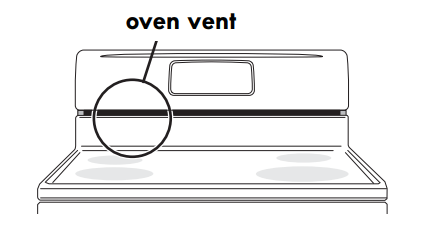
Figure 2: Do not block oven vent location
Protective Liners — Do not use aluminum foil to line the oven bottom. Only use aluminum foil as recommended in this manual. Improper installation of these liners may result in risk of electric shock or fire.
Removing, replacing, and arranging flat or offset oven racks
To Arrange - Always arrange the oven racks when the oven is cool (prior to operating the oven).
To Remove - Pull the oven rack straight forward until it reaches the stop position. Lift up front of oven rack slightly and slide out.
To Replace - Place the oven rack on the rack guides on both sides of oven walls. Tilt the front of oven rack upward slightly and slide the oven rack back into place. Be sure oven racks are level before using.

Figure 3: Oven rack types
Oven Rack Descriptions
- Flat oven racks (or the flat handle oven rack) may be used for most cooking needs and may be placed in most oven rack positions.
- The offset oven rack (some models) provides additional stepdown positions from the standard flat rack design. The offset design positions the base of the rack about 1/2 of a rack position lower than the flat rack and may be used in most oven rack positions.
- To maximize oven cooking space, place the bottom oven rack (some models) in the lowest rack position for baking or roasting large cuts of meat.
Air circulation in the oven
For best baking results allow 2-4" (5-10 cm) around the cookware for proper air circulation and be sure pans and cookware do not touch each other, the oven door, sides or back of the oven cavity. Hot air must be able to circulate around the cookware in the oven for even heat to reach around the food.
Before Setting Surface Controls
Using Proper Cookware
The size and type of cookware used will influence the radiant element power level setting needed for best cooking results. Be sure to follow the recommendations for using proper cookware as illustrated in both Figure 4 and Figure 5.

Figure 4 Testing cookware
Check for flatness by rotating a ruler across the bottom of the cookware (See Figure 4). Cookware should have flat bottoms that make good contact with the entire surface heating element (See Figure 5). For detailed information about the ceramic cooktop, refer to the “Cooktop Maintenance” on page 35.
Figure 5: Proper cookware placement

- Flat bottom and straight sides.
- Tight fitting lids.
- Weight of handle does not tilt pan. Pan is well balanced.
- Pan sizes match the amount of food to be prepared and the size of the surface element.
- Made of material that conducts heat well.
- Easy to clean.
- Always match pot diameter to element size.
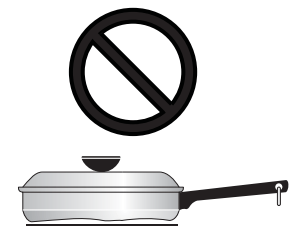
- Curved and warped pans.
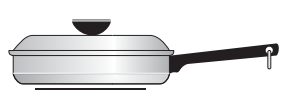
- Cookware larger than cooking area marked on cooktop by more than one-half inch or 12mm.

- Heavy handle tilts pan.

- Pan is smaller than the heating area marked on cooktop.
Cookware Material Types
The cookware material determines how evenly and quickly heat is transferred from the surface element to the pan bottom. The most popular materials available are:
Aluminum - Excellent heat conductor. Some types of food will cause it to darken (Anodized aluminum cookware resists staining and pitting). If aluminum pans slide across the ceramic cooktop, they may leave metal marks which will resemble scratches. Remove these marks immediately.
Copper - Excellent heat conductor but discolors easily (See Aluminum).
Stainless - Slow heat conductor with uneven cooking results. Is durable, easy to clean and resists staining.
Cast Iron - A slow heat conductor however will retain heat very well. Cooks evenly once cooking temperature is reached. Not recommended for use on ceramic cooktops.
Porcelain-enamel on metal - Heating characteristics will vary depending on base material. Porcelain-enamel coating must be smooth to avoid scratching ceramic cooktops.
Glass - Slow heat conductor. Not recommended for ceramic cooktop surfaces because it may scratch the glass.
Important note:
Do not place empty aluminum, glass or porcelain-enamel coated cookware on the ceramic cooktop! The melting point of cookware made with these materials may be reached quickly especially if left empty, and they may bond to the ceramic cooktop. If the cookware melts it will damage the cooktop! Be sure to follow all the cookware manufacturer’s suggestions when using any type of cookware on the ceramic cooktop.
About the Ceramic Glass Cooktop
The ceramic cooktop has radiant surface elements located below the surface of the glass. The design of the ceramic cooktop outlines the area of the surface element underneath. Be sure to match the pan size with the diameter of the element outline on the cooktop and only flat-bottomed cookware should be used.
The type and size of cookware, the number of surface elements in use and their settings are all factors that will affect the amount of heat that will spread to areas beyond the surface elements. The areas surrounding the elements may become hot enough to cause burns.
About the Radiant Surface Elements
The element temperature rises gradually and evenly. As the temperature rises, the element will glow red. To maintain the selected setting the element will cycle on and off. The heating element retains enough heat to provide a uniform and consistent heat during the off cycle.
For efficient cooking, turn off the element several minutes before cooking is complete. This will allow residual heat to complete the cooking process.
Element On and Hot Surface Indicator Lights
Your appliance is equipped with two different types of surface control indicator lights that will glow on the control panel — the ELEMENT ON indicator light and the Hot Surface indicator lights.
The ELEMENT ON indicator lights are marked on the control panel and will glow when a surface cooking element is turned on. A quick glance at these indicator lights after cooking is an easy check to be sure all surface controls are turned off.
The Hot Surface indicator lights are located on the control panel just above each surface control knob. They will glow when any surface cooking area heats up and will remain on until the cooktop has cooled to a moderate level.

Figure 6: Element indicator light
Important notes:
- Never place or straddle a cooking utensil over two different surface cooking elements at the same time unless the utensil is designed for that purpose. This can cause uneven heating results. This can also cause the ceramic cooktop to fracture (for ceramic cooktop models only).
- Radiant elements have a limiter that allows the radiant heating element to cycle on and off, even at the HI setting. This helps to prevent damage to the ceramic smooth top. Cycling at the HI setting is normal and will occur more often if the cookware is too small for the radiant element or if the cookware bottom is not flat.
- Be sure to read the detailed instructions for ceramic glass cooktop maintenance and cleaning in the Care & Cleaning and Before You Call checklist sections of this Use & Care Guide.
Types of Cooktop Surface Elements Single and Dual Radiant Elements
The ceramic glass cooktop has radiant surface elements located below the surface of the glass. The patterns on the ceramic glass will outline the size and type of element available. The single radiant element or elements will have one round outline pattern shown on the cooktop. A dual (on some models) radiant element allows the user to set the smaller inner portion as a single element or both inner and outer portions may be set to heat together (See Figure 7).
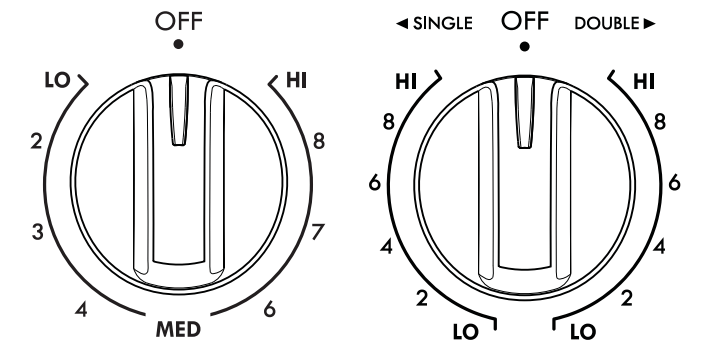
Figure 7: Single (L) and dual (R) radiant elements
Warmer Zone Control, Turboboil Flex, and Triple Radiant Element
The warmer zone feature located on the center rear area of the cooktop uses one round outline and is designed to keep food warm only.
Your range is equipped with the turboboil flex boiling element, the fastest and most powerful element available on the market today. The element allows you to bring liquids to a boil in record time, as well as maintain liquids consistently at a low, warm simmer.
The triple radiant element (some models) has three element portions and may be set to heat as 1 (single), 2 (dual), or 3 (triple) element portions together.
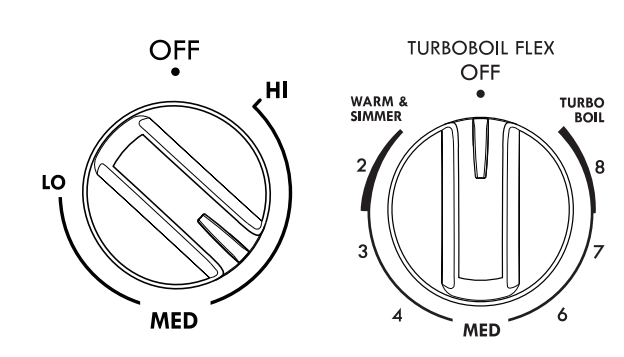
Figure 8: Warmer zone control (L) and Turboboil Flex (R)
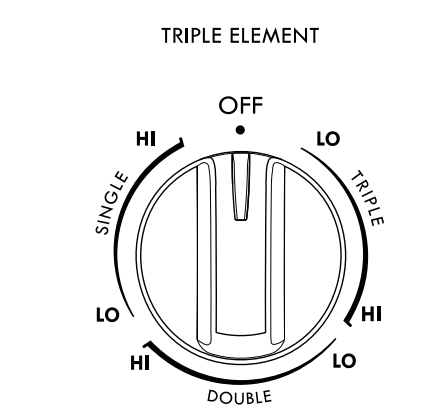
Figure 9: Triple radiant element
Home Canning
Be sure to read and observe all the following points when home canning with your appliance. Check with the USDA (United States Department of Agriculture) Web site and be sure to read all the information they have available as well as follow their recommendations for home canning procedures.
- Use only quality flat bottom canners when home canning. Use a straight-edge to check canner bottom.
- Use only a completely flat bottom canner with no ridges that radiate from the bottom center when home canning. Heat is spread more evenly when the bottom surface is flat.
- Make sure the diameter of the canner does not exceed 1 inch beyond the surface element markings or burner. It is recommended to use smaller diameter canners on electric coil and ceramic glass cooktops and to center canners on the burner grates.
- Start with hot tap water to bring water to boil more quickly.
- Use the highest heat seating when first bringing the water to a boil. Once boiling is achieved, reduce heat to lowest possible setting to maintain that boil.
- Use tested recipes and follow instructions carefully. Check with your local Cooperative Agricultural Extension Service or a manufacturer of glass jars for the latest canning information.
- It is best to can small amounts and light loads.
- Do not leave water bath or pressure canners on high heat for an extended amount of time.
- Alternate surface units between each batch to allow the units and surrounding surfaces to cool down. Try to avoid canning on the same burner unit all day.
Setting Surface Controls
Radiant Surface Element Settings
The size and type of utensil used, and the amount and type of food being cooked will influence the surface element power level setting needed for best cooking results.
The suggested settings found in Table 1 are based when cooking with medium-weight aluminum pans with lids. Settings may vary when using other types of pans.
Table 1: Suggested settings for single, dual, and triple radiant surface elements
Settings | Type of cooking |
High (HI) | Start most foods, bring water to a boil, pan broiling |
Medium high (7 - 8) | Continue a rapid boil, fry, deep fat fry |
Medium (5 - 6) | Maintain a slow boil, thicken sauces and gravies or steam vegetables |
Medium Low (2 - 4) | Keep foods cooking, poach, stew |
Low (LO - 1) | Keep warm, melt, simmer |
Important notes:
- For efficient cooking, turn off the element several minutes before cooking is complete. This will allow residual heat to complete the cooking process.
- The surface control knobs do not have to be set exactly on a particular spot. Use the graphics provided as a guide and adjust the control knob as needed. Each surface element provides a constant amount of heat at each setting. Refer to Table 1 for suggested power level settings.
- Start most cooking operations on a higher setting and then turn to a lower setting to finish cooking.
- Radiant elements have a limiter that allows the radiant heating element to cycle on and off, even at the HI setting. This helps prevent damage to the ceramic smoothtop. Cycling at the HI setting is normal and will occur more often if the cookware is too small for the radiant element or if the cookware bottom is not flat.
- A glowing red surface heating area extending beyond the bottom edge of the cookware indicates the cookware is too small for the surface heating area.
Single Radiant Surface Elements (all models)
To operate the single radiant element (all models):
- Place correctly sized cookware on single radiant surface element.
- Push in and turn the surface control knob in either direction to the desired setting (See Figure 10).
- When cooking is complete, turn the radiant surface element OFF before removing the cookware.

Figure 10: Single radiant element
Turboboil Flex Element
Your range is equipped with the turboboil flex boiling element, the fastest and most powerful element available on the market today. The element allows you to bring liquids to a boil in record time, as well as maintain liquids consistently at a low, warm simmer.
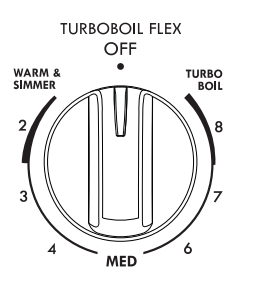
Figure 11: Turboboil Flex
Dual Radiant Surface Element (some models)
To operate the dual radiant element:
- Place correctly sized cookware on single radiant surface element.
- Push in and turn the surface control knob clockwise to begin heating both the inner and outer portions of the element (marked dual - See Figure 12). If only the inner heating portion is needed (marked single - See Figure 12) for smaller cookware, push in and turn the knob counter-clockwise.
Important note: You may switch from the single or dual settings at any time during cooking. - When cooking is complete, turn the radiant surface element off before removing the cookware.
Important notes:
- For efficient cooking, turn off the element several minutes before cooking is complete. This will allow residual heat to complete the cooking process.
- The surface control knobs do not have to be set exactly on a particular spot. Use the graphics provided as a guide and adjust the control knob as needed. Each surface element provides a constant amount of heat at each setting. Refer to Table 1 for suggested power level settings.
- Start most cooking operations on a higher setting and then turn to a lower setting to finish cooking.
- Radiant elements have a limiter that allows the radiant heating element to cycle on and off, even at the HI setting.
- This helps prevent damage to the ceramic smoothtop. Cycling at the HI setting is normal and will occur more often if the cookware is too small for the radiant element or if the cookware bottom is not flat.
- A glowing red surface heating area extending beyond the bottom edge of the cookware indicates the cookware is too small for the surface heating area.
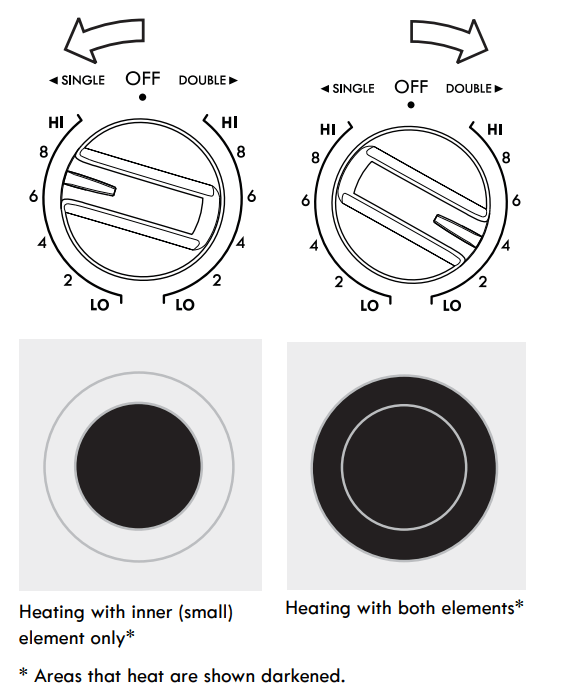
Figure 12: Dual radiant surface element operation
Triple Radiant Surface Element (some models)
To operate the triple radiant element:
- Place correctly-sized cookware on single radiant surface element.
- Push in and turn the surface control knob clockwise to begin heating both the inner and outer portions of the element (See Figure 13 and Figure 14). If only the inner heating portion is needed for smaller cookware, push in and turn the knob counter-clockwise (See Figure 13 and Figure 14). Please note that all three element portions will adjust to the same power level.
Important note: You may switch from the single, dual, or triple settings at any time during cooking. - When cooking is complete, turn the radiant surface element off before removing the cookware.
Important notes:
- For efficient cooking, turn off the element several minutes before cooking is complete. This will allow residual heat to complete the cooking process.
- The surface control knobs do not have to be set exactly on a particular spot. Use the graphics provided as a guide and adjust the control knob as needed. Each surface element provides a constant amount of heat at each setting. Refer to Table 1 for suggested power level settings.
- Start most cooking operations on a higher setting and then turn to a lower setting to finish cooking.
- Radiant elements have a limiter that allows the radiant heating element to cycle on and off, even at the HI setting. This helps prevent damage to the ceramic smoothtop. Cycling at the HI setting is normal and will occur more often if the cookware is too small for the radiant element or if the cookware bottom is not flat.
- A glowing red surface heating area extending beyond the bottom edge of the cookware indicates the cookware is too small for the surface heating area.
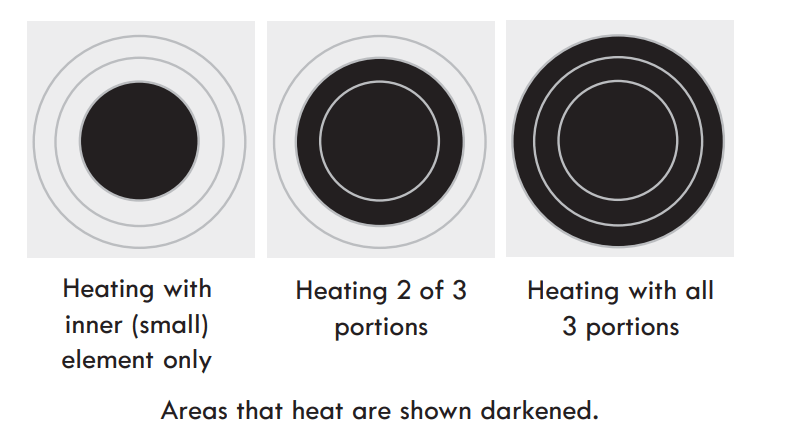
Figure 13: Triple radiant element zones: single (L), double (M), and Triple (R)
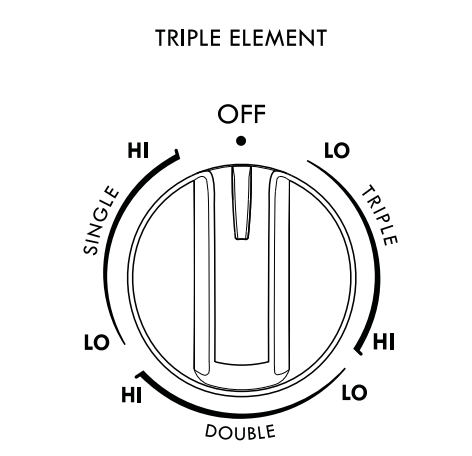
Figure 14: Triple radiant element
Warm & Ready Zone (some models)
The purpose of the warmer zone is to keep hot cooked foods at serving temperature. Use the warmer zone feature (See Figure 15) to keep cooked foods hot such as; vegetables, gravies, casseroles, soups, stews, breads, pastries and oven-safe dinner plates.
Always start with hot food. Do not heat cold food with the warmer zone. All food placed on the warmer zone should be covered with a lid to maintain quality.
For best results, when warming pastries or breads, the cover should have an opening to allow moisture to escape. Use only dishware, utensils and cookware recommended for oven and cooktop use on the warmer zone.
Setting warmer zone control:
- Push in either direction and turn the warmer zone control knob to the desired temperature level (See Figure 15). The temperatures are approximate, and are designated by HI (high), MED (medium) and LO (low). However, the control can be set at any position between HI and LO for different levels of warming.
- When ready to serve, turn the warmer zone control knob to OFF position. The warmer zone will remain hot until the hot surface indicator light turns off.
Important notes:
- The warmer zone temperature level may be adjusted at any time when the warmer zone is turned on.
- Use only plates, utensils and cookware recommended for oven and ceramic cooktop use. Do not use plastic wrap or aluminum foil to cover food. Plastic or aluminum foil can melt onto the cooktop
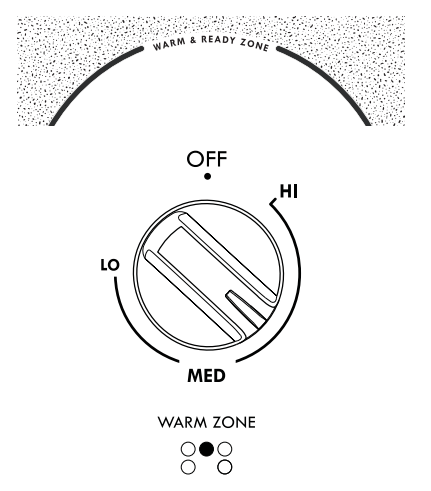
Figure 15: Warm zone element
Temperature selection - Refer to the warmer zone recommended food settings (See Table 2). If a particular food is not listed, start with the medium level, and adjust as needed. Most foods can be kept at serving temperatures using the medium setting.
Table 2: Warmer zone recommended food settings
Food Item | Heating Level |
Breads/Pastries | LO (Low) |
Casseroles | LO (Low) |
Dinner Plates with Food | LO (Low) |
Eggs | LO (Low) |
Gravies | LO (Low) |
Meats | MED (Medium) |
Sauces | MED (Medium) |
Soups (cream) | MED (Medium) |
Stews | MED (Medium) |
Vegetables | MED (Medium) |
Fried Foods | HI (High) |
Hot Beverages | HI (High) |
Soups (liquid) | HI (High) |
Oven Controls
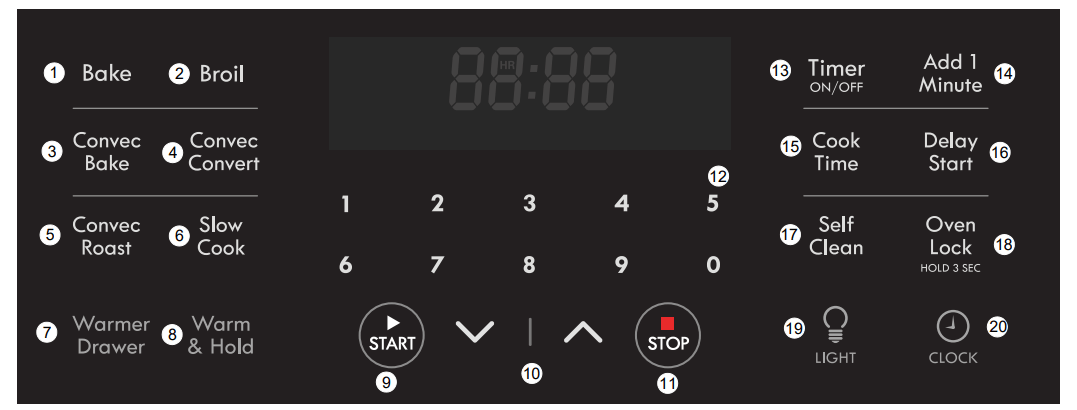
- Bake - Use to start a normal Bake function.
- Broil - Use to select Broil function.
- Convec Bake - Use to select Conv Bake function.
- Convec Convert - Use to select Conv Convert function.
- Convec Roast - Use to select Conv Roast function.
- Slow Cook - Use to select Slow Cook function.
- Warmer Drawer (some models) - Use to select Warmer Drawer function.
- Warm & Hold - Use to keep cooked food warm and at serving temperature for up to 3 hours.
- START - Use to start oven functions.
- Up / Down arrows - Use with the function keys to adjust settings and adjust temperature and times.
- STOP - Use to cancel any oven function previously entered except clock and timer.
- 0-9 keypad - Use to enter oven temperatures and times.
- Timer ON/Off - Use to set and cancel the timer.
- Add 1 Minute - Use to add one minute to the timer. This works with the kitchen timer and does not affect any cook time or start time functions.
- Cook Time - Use to set a specific amount of time needed for cooking. Automatically cancels cooking process at end of set time.
- Delay Start - Use with Bake, Conv Bake, Conv Concert, and Self Clean functions to program a delayed start time.
- Self Clean - Use to select 2, 3, or 4 hr Self-Clean cycle.
- Oven Lock - Use to lock oven door and oven functions.
- LIGHT - Use to turn internal oven light on and off.
- CLOCK - Use to set time of day.
Minimum and Maximum Control Settings
All of the features listed have minimum and maximum time and temperature settings that may be entered into the control. An entry acceptance beep will sound each time a key is touched. An entry error tone (three short beeps) will sound if the entry of the temperature or time is below the minimum allowable setting or above the maximum setting for the cooking feature. The error tone will also sound any time a key is pressed if the entry is determined to be an invalid selection.
Important note:
The oven control works with both the numeric keypad and the Up / Down arrow keys. For cooking functions (Bake, Broil, Convec Bake, Convec Convert, Convec Roast, and Slow Cook) as well as for the Timer ON/OFF and the CLOCK functions, you may press the Up / Down arrows to adjust the temperature in addition to (or instead of) using the digital keys. Regardless of the method you choose, always press the START key to initiate the function.
Please be aware that the Up / Down arrows will not operate with the following functions: Warmer Drawer, Add 1 Minute, and Warm & Hold. If an arrow key is pressed in an attempt to program any given function that is invalid, the control will sound a triple beep.
Table 3: Minimum and maximum control settings
Feature | Min. Temp or Time | Max. Temp or Time |
Bake | 170°F (77°C) | 550°F (288°C) |
Broil | 400°F (205°C) | 550°F (288°C) |
Timer | 1 minute | 11 hrs. 59 mins. |
Self Clean | 2 Hours | 4 Hours |
Warm & Hold | 170°F (77°C) | 3 Hours |
Cook Time | 1 Minute | 11:59 |
Delay Time 12 Hr. | 1:00 | 12:59 |
Delay Time 24 Hr. | 0:00 | 23:59 |
Convec Bake | 170°F (77°C) | 550°F (288°C) |
Convec Convert | 170°F (77°C) | 550°F (288°C) |
Convec Roast | 170°F (77°C) | 550°F (288°C) |
Clock 12 Hr. | 1:00 | 12:59 |
Clock 24 Hr. | 0:00 | 23:59 |
Slow Cook | LO 225°F (108°C) | HI 275°F (134°C) |
Setting Clock
When the appliance is first powered up, 12:00 will flash in the display (See Table 16). The time of day must first be set before operating the oven.

Figure 16: 12:00 in display before setting the clock
To set clock to 1:30:
- Press
 .
. - Enter 1 3 0 using numeric keypad or press the Up / Down arrow keys until 130 appears in the display.
- Press
 .
.
Important note: The clock cannot be changed when a Cook Time, Self Clean, Delay Start, or cooking feature is active.
Setting Timer
The minute timer allows you to track your cooking times without interfering with the cooking process. The timer may be set from a minimum time of 1 minute to a maximum of 11 hours and 59 minutes.
To set timer for 5 minutes:
- Press Timer ON/OFF.
- Enter 5 using numeric keypad or press the Up arrow key until 5 appears in the display.
- Press
 to start the timer. When set time ends, END will show in the display and the control will sound a beep three times every 30 seconds until Timer ON/OFF key is pressed.
to start the timer. When set time ends, END will show in the display and the control will sound a beep three times every 30 seconds until Timer ON/OFF key is pressed.
To cancel the timer when active, press Timer ON/OFF again.
Important note:
- The timer does not start or stop the cooking process. It serves as an extra minute timer that will beep when the set time has run out. The timer may be used alone or while using any of the other oven functions.
- When timer is set for more than 1 hour it will display hours and minutes until 1 hour remains. When less than 1 hour remains, the display counts down in minutes and seconds. With less than 1 minute remaining, only seconds will display.
- If the timer is active during a cooking process, the timer will show in the display. To view the status of any other active oven function, press the key of the cooking function once and it will appear in the display for a few seconds.
Add 1 Minute
Use the Add 1 Minute feature to set additional minutes to the timer. Each press of the key will add 1 additional minute. If Add 1 Minute is pressed when the timer is not active, the timer will activate and begin counting down from 1 minute.
To add 2 minutes to the timer:
Press Add 1 Minute twice.
Setting Oven Lockout
The control may be programmed to lock the oven door and lock the oven control keys.
To activate the oven lockout features:
- Be sure oven door is completely closed.
- Press and hold the Oven Lock key for 3 seconds. The motor driven door latch mechanism will begin locking the oven door automatically. Do not open the oven door. Allow about 15 seconds for the oven door to completely lock. Once door is locked, the word DOOR with a lock icon will appear in the display.
To cancel the oven lockout feature:
- Press and hold the Oven Lock key for 3 seconds. The motor door latch will begin unlocking the oven door automatically. Do not open the oven door. Allow about 15 seconds for the oven door to completely unlock.
- When the word DOOR with a lock icon no longer displays, the oven door may be opened, and the oven control keypad will be available for use.
Important note:
- To avoid damage to the oven door latching mechanism, do not attempt to open or close the oven door whenever the word DOOR with a lock icon is displayed.
- If a control key is pressed when oven lockout is active, the control will triple beep indicating the key action is not available when the oven lockout feature is active.
Operating Oven Lights
The interior oven lights will automatically turn on when the oven door is opened. Oven lights will not operate during a self clean cycle.
Press  to turn the interior oven lights on and off whenever the oven door is closed.
to turn the interior oven lights on and off whenever the oven door is closed.
The interior oven lights are located on the rear wall of the oven interior and are covered with a glass shield. The glass shield protects the bulb from high temperatures and should always be in place whenever the oven is in use.
To replace the interior oven light, see “Replacing oven light (some models)” on page 36.
Setting Bake
Use the bake feature whenever the recipe calls for baking using normal temperatures. A reminder tone will sound indicating when the set bake temperature is reached and to place the food in the oven.
Bake may be set for any oven temperature between 170°F (77°C) to 550°F (288°C).
To set Bake for oven temperature of 425°F:
- Press Bake.
- Enter 4 2 5 using numeric keypad or press the Up arrow key until 4 2 5 appears in the display.
- Press
 . The word BAKE will appear on the display.
. The word BAKE will appear on the display.
To cancel Bake at any time, press .
.
- Baking tips
- When baking using two oven racks, position bakeware as shown in Figure 21. Allow at least 2 inches (5 cm) of space between bakeware for proper air circulation.
- Dark or dull pans absorb more heat than shiny bakeware, resulting in dark or overbrowning of foods. It may be necessary to reduce the oven temperature or cook time to prevent overbrowning of some foods. Dark pans are recommended for pies. Shiny pans are recommended for cakes, cookies, and muffins.
- Glass cookware is a slow heat conductor. May require reducing oven temperature.
- Minimize opening of the oven door. Opening the door will reduce the temperature in the oven.
- For batter and dough-based baked goods such as cakes, pastries, and breads, use the regular bake function for best results.
- Fully preheat the oven before cooking items like cookies, biscuits, and breads.
- When using any single rack, position the rack so that the food is in the center of the oven.
- For best results when baking cakes or cookies using two oven racks, place racks in positions 3 and 6 (See Figure 22) and place pans as shown in Figure 21.
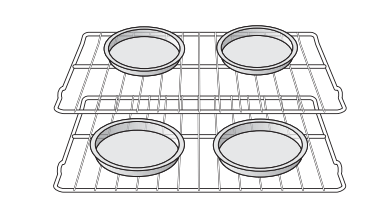
Figure 21: Baking on multiple levels
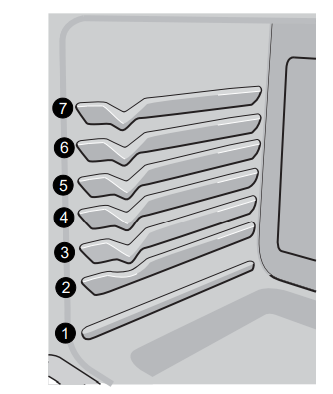
Figure 22: Oven rack positions
Important note: The oven will bake no longer than 12 hours. If you wish to bake for a longer period, see “Setting Cook Time” on page 22 for detailed information.
Convec Bake
Benefits of convection cooking include:
- Foods can cook up to 25 to 30% faster.
- Multiple rack baking.
- When using convection, use cookware or pans with low sides. This allows the air to circulate around the food evenly.
Convection functions use a fan to circulate the oven's heat uniformly and continuously around the oven. This improved heat distribution allows for fast, even cooking and browning results. It also gives better baking results when using two oven racks at the same time. Heated air flows around the food from all sides, sealing in juices and flavors. Breads and pastry brown more evenly. Most foods baked in a standard pan will cook faster and more evenly with the convection feature. Convec Bake may be set for any oven temperature between 170°F (77°C) and 550°F (288°C).
To set Convec. Bake with a default oven set temperature of 350°F:
- Press Conv Bake.
- Press
 .
.
To cancel Conv Bake at any time press 
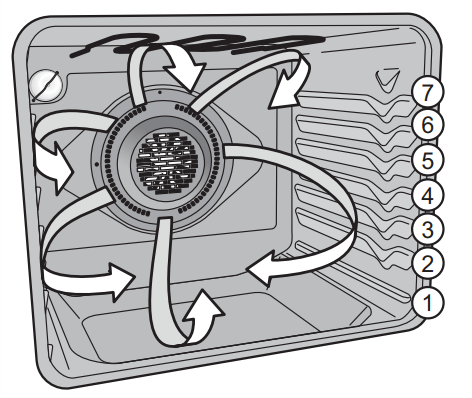
.Figure 24: Air movement using convection
Important notes:
- If the oven door is opened when Convec Bake is active, the convection fan will stop rotating until the oven door is closed.
- When using Convec Bake, cook time reductions may vary depending on the amount and type of food being cooked.
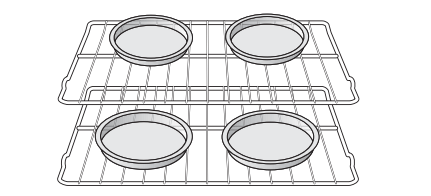
Figure 25: Baking on multiple levels
Baking tips
- Fully preheat the oven before cooking items like cookies, biscuits, and breads.
- When using any single rack, position the rack so that the food is in the center of the oven.
- Dark or dull bakeware absorbs more heat than shiny bakeware. It may be necessary to reduce oven temperature and cook time to prevent overbrowning of some foods. Dark bakeware is recommended for pies. Shiny bakeware is recommended for cakes, cookies, and muffins.
- Glass cookware may require reduced temperatures.
- Use pans or cookware with low sides. This allows the air to circulate around food evenly.
- Reduce oven temperature 25°F from recipe's recommended oven temperature. Follow the remainder of the recipe's instructions using the minimum recommended cook time.
- When using two oven racks, place in positions 2 and 5 (See Figure 24). When using three oven racks, place in positions 2, 4, and 7 (use offset rack only in position 7).
Setting Broil
Use the Broil function to cook meats that require direct exposure to radiant heat for optimum browning results. The Broil feature is factory preset to broil at 550°F. The Broil function temperature may be set at any temperature between 400°F (205°C) and 550°F (288°C).
The suggested broil settings are recommendations only (See Table 4). Depending on cooking preferences, you can increase or decrease cooking times or move food to a different rack position. If the food you are broiling is not listed in the table, follow the instructions provided in your cookbook and watch the item closely.
To set Broil with the default broil oven temperature of 550°F:
- Arrange the oven racks when cool. For optimum browning results, preheat oven for 5 minutes before adding food.
- Position bakeware in oven. Leave door open at the broil stop position (See Figure 28).
- Press Broil.
- Press
 . To set to a lower broil temperature, press and hold the Down arrow key until the desired temperature is reached. The lowest setting the oven control will accept for Broil is 400°F. To adjust the Broil temperature, press Broil again and then the Up or Down arrow key to set the desired temperature.
. To set to a lower broil temperature, press and hold the Down arrow key until the desired temperature is reached. The lowest setting the oven control will accept for Broil is 400°F. To adjust the Broil temperature, press Broil again and then the Up or Down arrow key to set the desired temperature. - Broil on one side until food is browned; turn an broil other side until done to your satisfaction.
- When finished broiling, press

- To cancel Broil at any time, press STOP.
Important notes:
- Always arrange oven racks when the oven is cool.
- For best results when broiling, use a broil pan with broil pan insert designed to drain the fat from the food and help avoid spatter and reduce smoking. To purchase them, call Sears at 1-800-4-MY-HOME (1-800-4663) and order broil pan kit 5304442087.
- When broiling, always pull the oven rack out to the stop position before turning or removing food.
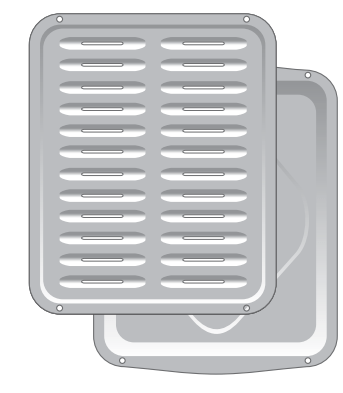
Figure 27: Broiler pan/insert
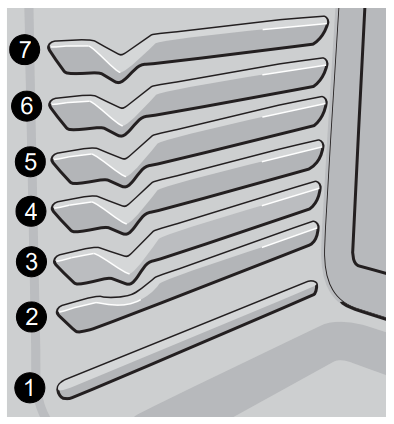
Figure 28: Rack positions
Table 4: Suggested Broil Settings1
Food | Rack Position | Setting | Cook time in minutes 1st side 2nd side | Doneness | |
Steak, 1 inch thick | 6th or 7th | 550°F | 8 | 6 | Medium |
Steak, 1 inch thick | 5th or 6th | 550°F | 10 | 8 | Medium-well |
Steak, 1 inch thick | 5th or 6th | 550°F | 11 | 10 | Well |
Pork Chops, 3/4 inch thick | 5th | 550°F | 12 | 8 | Well |
Chicken, bone-in | 5th | 450°F | 25 | 15 | Well |
Chicken, boneless | 5th | 450°F | 10 | 8 | Well |
Fish | 5th | 550°F | as directed | Well | |
Shrimp | 4th | 550°F | as directed | Well | |
Hamburger, 1 inch | 5th or 6th | 550°F | 12 | 10 | Medium |
1. For steaks, cook times are suggestions and should only be used as a guide.
Setting Slow Cook
The Slow Cook feature cooks foods more slowly and at lower oven temperatures for longer periods of time. Slow Cook is ideal for roasting beef, pork and poultry. Slow cooking meats may result in the exterior of meats becoming dark but will not burn the outside as it seals in the meat’s juices.
Two Slow Cook settings are available: high (Hi) and low (Lo). The high setting is best for cooking foods between 4 and 5 hours. The low setting is best for cooking foods up to 9 hours or longer.
Some tips for best results when using Slow Cook:
- Completely thaw all frozen foods before cooking.
- When using a single oven rack, place in oven rack position 2 or 3. Position racks to accommodate the size of various bakeware when cooking multiple food items.
- Do not open the oven door often or leave the door open when checking foods. If the oven heat escapes often, the Slow Cook time may need to be extended.
- Cover to keep foods moist or use a loose or vented type cover to allow foods to turn crisp or brown.
- Roasts may be left uncovered so browning can occur. Cook times will vary depending on the weight, fat content, bone, and the shape of the roast. Preheating the oven will not be necessary when using the Slow Cook feature.
- Add any cream or cheese sauces during the last hour of cooking.
Important note:
- Slow Cook may be used with additional settings of Cook Time and Delay Start.
- The maximum cook time for Slow Cook function is 11 hours and 59 minutes unless the control has been changed to the continuous bake mode.
To set Slow Cook:
Doing so can result in food poisoning or sickness. Foods that can easily spoil such as milk, eggs, fish, meat or poultry, should be chilled in the refrigerator first. Even when chilled, they should not stand in the oven for more than 1 hour before cooking begins, and should be removed promptly when finished cooking.
- Position bakeware in oven and close oven door.
- Press Slow Cook. HI will appear in the display, indicating the default temperature setting is for high.
- If a low setting is needed, press the Down arrow key to select the low setting.
- Press
 to activate Slow Cook.
to activate Slow Cook.
To cancel Slow Cook at any time, press .
.
Warm & Hold should only be used with foods that are already at serving temperatures. Warm & Hold will keep cooked foods warm and ready for serving for up to 3 hours after cooking has finished. After 3 hours the Warm & Hold will shut-off automatically. Warm & Hold will keep the oven temperature at 170° F (77°C).
Warm & Hold™
Warm & Hold should only be used with foods that are already at serving temperatures. Warm & Hold will keep cooked foods warm and ready for serving for up to 3 hours after cooking has finished. After 3 hours the Warm & Hold will shut-off automatically. Warm & Hold will keep the oven temperature at 170° F (77°C).
To set Warm & Hold:
- If needed, arrange oven racks and place cooked food in oven.
- Press Warm & Hold. Hold WARM will appear in the display. (If no other keys are touched within 25 seconds the request for Warm & Hold will clear.)
- Press
 . Warm & Hold will automatically turn on and then turn off after 3 hours unless cancelled.
. Warm & Hold will automatically turn on and then turn off after 3 hours unless cancelled.
To turn Warm & Hold off at any time, press  .
.
To add Warm & Hold to turn ON after baking 45 minutes with a set temperature of 425°F:
Food poisoning hazard. Do not let food sit for more than one hour before or after cooking. Doing so can result in food poisoning or sickness. Foods that can easily spoil such as milk, eggs, fish, meat or poultry, should be chilled in the refrigerator first. Even when chilled, they should not stand in the oven for more than 1 hour before cooking begins, and should be removed promptly when finished cooking.
- Press Cook Time.
- Enter 4 5 using numeric keypad.
- Press
 .
. - Press Bake and enter 425 on numeric keypad.
- Press to accept.
- Press Warm & Hold. Hold WARM will appear in the display.
- Press
 . When the cook time is over, the Warm & Hold will automatically turn ON. The Warm & Hold function will automatically turn OFF after 3 hours.
. When the cook time is over, the Warm & Hold will automatically turn ON. The Warm & Hold function will automatically turn OFF after 3 hours.
Important note:
- Warm & Hold will maintain the oven temperature at 170° F (77°C) for 3 hours.
- Warm & Hold may be set when finished cooking or may be added to automatically turn on after cooking using Cook Time. Delay Start may also be added.
Setting the Sabbath feature (for use on the Jewish Sabbath and Holidays)

This appliance provides special settings for use when observing the Jewish Sabbath/Holidays. Sabbath mode disables all audible tones or visual display changes on the oven control. Bake heating is the only cooking feature available while in the Sabbath mode. Oven controls are locked during Sabbath mode.
You must first set the Bake feature and temperature(s) needed for the oven, the Cook Time, and Delay Start options (if needed). Any settings made prior to setting the Sabbath mode will be visible in the displays. The Cook Time option, if set prior to the Sabbath mode, will give one audible alert at the end of Cook Time.
The Sabbath mode will override the factory preset 12 hour energy saving mode, and the appliance will stay on until the cooking features are cancelled. If any of the cooking features are cancelled when the appliance is in the Sabbath mode, no audible or visual indicators will be available to verify the cancellation.
If the oven interior lights are needed, be sure to activate them prior to setting the Sabbath mode. Once the oven light is turned on and the Sabbath mode is active, the oven light will remain on until the Sabbath mode is turned off and the oven lights are turned off. The oven door will not activate the interior oven lights when the oven door is opened or closed.
It is recommended that any oven temperature modification made within an active Sabbath mode be followed with two presses of the START key. This will insure the oven remains on even if an attempt is made to set the oven temperature outside of its temperature range. If the oven temperature is set outside of the temperature range, the oven will default to the nearest available temperature. Try to set the desired oven temperature again.
To program oven to Bake with default oven temperature of 350°F and activate the Sabbath feature:
- Be sure the clock is set with the correct time of day.
- Arrange oven racks, place bakeware in oven, and close oven door.
- Press Bake.
- Press
 .
. - If Cook Time or Delay Start are not needed, skip this step and continue to step 6. If a Cook Time or Delay Start are desired enter the times at this point. See “Setting Cook Time” and “Setting Delay Start” on page 22 for detailed instructions.
- Press and hold Cook Time and Delay Start simultaneously for about 3 seconds to set the Sabbath feature. Once the feature is set, SAb will appear in the display indicating the oven is properly set for the Sabbath feature (See Figure 29).

Figure 29: Oven set for Sabbath baking.
Important note:
- Do not attempt to activate any other oven function except Bake while the Sabbath feature is active. The following keys will function correctly when the Sabbath feature is active: 0-9 number keypad, Bake,
 , and
, and  . All other keys should not be used once the Sabbath feature is active.
. All other keys should not be used once the Sabbath feature is active. - You may change the oven temperature once baking has started. Press Bake, use the numeric keypad to enter the oven temperature change (170°F to 550F°), and press
 (for Jewish Holidays only).
(for Jewish Holidays only). - Remember that the oven control will no longer provide audible tones or display any further changes when the Sabbath feature is active.
- Remember the oven will shut-off automatically after completing a Cook Time, Delay Start, or Warm & Hold and therefore may only be used once during the Sabbath/ Jewish Holidays.
- If a Delay Start time longer than 11 hours and 59 minutes is desired, set the oven control for the 24 hour day display mode setting. For detailed instructions, see “Setting 12 Hour or 24 Hour Display Mode” on page 19 for more information.
Warmer Drawer (some models)
Warm & Ready™ Drawer
The purpose of the warmer drawer is to keep hot cooked foods at serving temperatures. Examples are vegetables, gravies, meats, casseroles, biscuits, rolls, and pastries. It is not recommended to heat cold food in the warmer drawer; always start with hot food. The warmer drawer may also be used to warm dinner plates. All food placed in the warmer drawer should be covered with a lid or aluminum foil to maintain quality.
Important note: Do not use plastic wrap to cover food. Plastic may melt onto the drawer and be very difficult to clean up. Use only utensils and cookware recommended by the manufacturer for use in the keep warm drawe
Arranging Warmer Drawer Rack Positions
The keep warmer drawer rack may be used in two ways:
- In the upright position (See Figure 31) to allow low profile food items to be placed both under and on top of the rack (for example, rolls or biscuits on top of the rack and a casserole dish underneath).
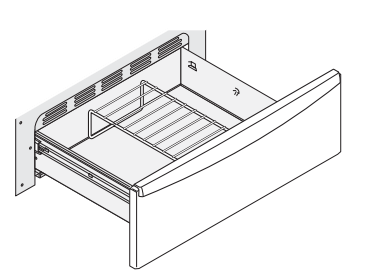
Figure 31: Upright position
- In the downward position (See Figure 32) to allow for light weight food items and empty cookware (for example, rolls, pastries, and dinner plates) on the rack.
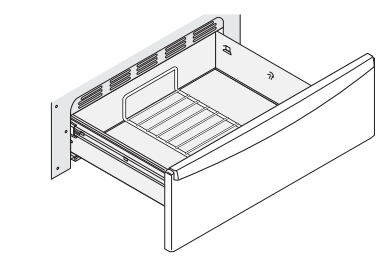
Figure 32: Downward position
Setting Warmer Drawer
To set warmer drawer:
- Open warmer drawer when cool and arrange warmer drawer rack as needed.
- For best results, close the warmer drawer and preheat the drawer before adding food or plates. An empty warmer drawer will fully preheat in approximately 15 minutes.
- Place food in warmer drawer that is already at serving temperature on warmer drawer rack. Dinner plates may be warmed also.
- Press Warmer Drawer, and then press START. The drawer will heat to 170°F.
- Always turn warmer drawer control off after use by pressing Warmer Drawer.
Important notes:
- Always start with hot food when using the warmer drawer. Do not heat cold food in the warmer drawer.
- Self Clean can not be set when the warmer drawer is active.
- The warmer drawer is equipped with a catch that may require extra force to open and close the drawer.
Removing and Replacing the Warmer Drawer
To remove the warmer drawer:
- Turn power OFF to the appliance before removing the warmer drawer.
- Open the warmer drawer completely.
- On left warmer drawer rail, locate black release lever and press up with finger while pulling out slightly on the oven drawer handle. On right warmer drawer rail, locate black release lever and press down with finger while pulling out slightly on the warmer drawer handle (See Figure 33).
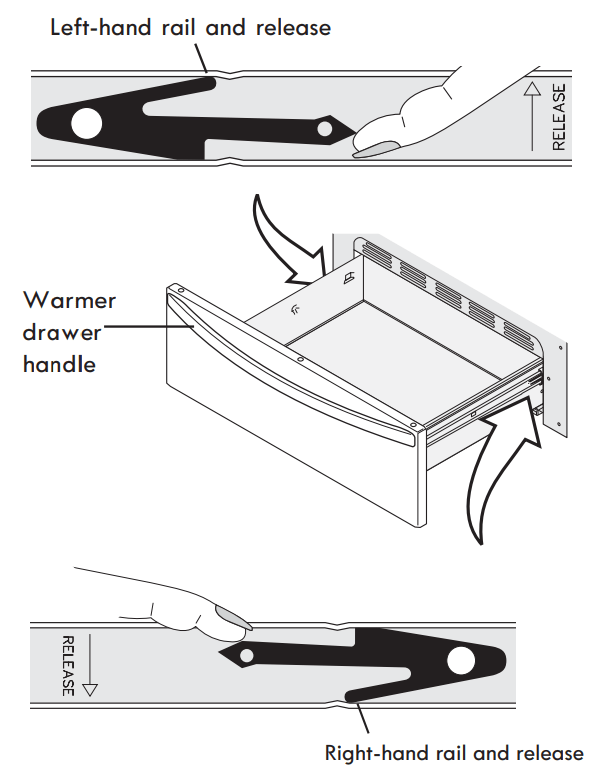
Figure 33: Removing the warmer drawer - The warmer drawer should now be released from the rails. Remove warmer oven drawer (using level and square motion) completely out and away from the appliance.
To replace the warmer drawer:
- Pull the bearing glides to the front of the outer compartment glide channels until they snap into place (See Figure 34).

Figure 34: Bearing glide placement - Carefully line up both sides of the warmer drawer glide rails to the outer compartment glide channels located inside the empty warmer drawer compartment (See Figure 35).

Figure 35: Channel alignment - While holding the warmer drawer level and square using the warmer drawer handle, push (do not force) the warmer drawer all the way into the outer compartment glide channels all the way into the range. Open the warmer drawer again to verify the glides have seated.
- If you do not hear the levers “click” or the bearing glides do not feel seated remove the warmer drawer and repeat Steps 1 through 3 again. This will minimize possible damage to the bearing glides.
Self Clean
A self cleaning oven cleans itself with high temperatures (well above normal cooking temperatures), which eliminate soils completely or reduces them to a fine powdered ash you can wipe away afterwards with a damp cloth.
The Self Clean function on this model can be programmed for any duration between 2 and 4 hours. Use the numeric keypad or the Up / Down arrow keys. Each arrow key pressed changes the time by 1 minute up or down. Press START.
Read before starting Self Clean. Be sure to read all following caution and important statements before starting a self clean cycle.
Important notes:
- Completely remove all oven racks and any accessories from oven cavity to avoid damage to oven racks. If the oven racks are not removed they may discolor. Remove all items from the oven and cooktop including cookware, utensils, and any aluminum foil. Aluminum foil will not withstand high temperatures from a self clean cycle and will melt.
- Do not use oven cleaners or oven protective coatings in or around any part of the oven interior. Clean any soil from the oven frame, the door liner outside the oven door gasket, and the small area at the front center of the oven bottom (See Figure 36). These areas heat sufficiently to burn soil on. Clean using soap and water prior to starting Self Clean.
- Remove any excessive spills. Any spills on the oven bottom should be wiped up and removed before starting a Self Clean cycle. To clean use hot, soapy water and a cloth. Large spills can cause heavy smoke or fire when subjected to high temperatures. Do not allow food spills with high sugar or acid content (such as milk, tomatoes, sauerkraut, fruit juices, or pie fillings) to remain on the surface as they may leave a dull spot even after cleaning.
- Do not clean the oven door gasket. The woven material in the gasket is essential for a good seal. Care should be taken not to rub, damage, or remove the oven door gasket. Doing so could cause damage to the door gasket and compromise the performance of the oven.
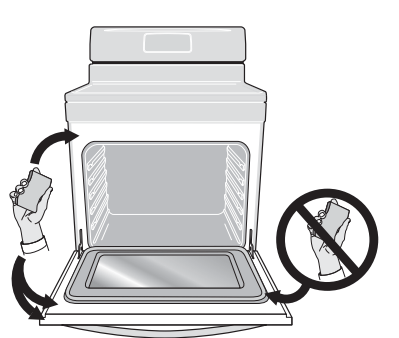
Figure 36: Areas to clean and to avoid
Important notes:
- The kitchen area should be well ventilated using an open window, ventilation fan, or exhaust hood during the first Self Clean cycle. This will help eliminate the normal odors.
- Do not attempt to open the oven door when the OVEN LOCK indicator light is flashing. Allow about 15 seconds for the motorized door latch mechanism to completely lock or unlock the oven door.
- When the clean time finishes, the oven door will remain locked until the range has cooled sufficiently. In addition to the clean time that was programmed, you must allow about 1 additional hour for the oven to cool before you will be able to open the oven door.
Setting Self Clean
To set self clean:
- Be sure the oven is empty and all oven racks are removed. Remove all items from the oven. Be sure oven door is completely closed.
- Press Self Clean and the default 3 hour clean time will appear in the display. You may accept the default 3 hour clean time by going to step 3, or choose a different clean time. Press Self Clean and use the numeric keypad or Up / Down arrow keys to select any time between 2 hours and 4 hours. Once you have the desired clean time selected proceed to Step 3.
- Press
 to activate Self Clean.
to activate Self Clean.
As soon as Self Clean becomes active, a motor driven lock mechanism will begin locking the oven door automatically. Do not attempt to open the oven door (allow 15 seconds for the lock mechanism to lock the oven).
Once the oven door has locked, CLEAN will appear in the display indicating Self Clean has started.
When Self Clean is finished:
- CLEAN message will turn off, and Hot will appear in display window.
- Once the oven has cooled down (about 1 hour) and Hot is no longer displayed, the oven door may be opened.
- When the oven interior has completely cooled, wipe away any residue or powdered ash with a damp cloth or paper towel.
Setting Delay Start Self Clean
To start a delay Self Clean with default clean time of 3 hours and a start time of 9:00 o’clock:
- Be sure the clock is set with the correct time of day, the oven is empty, and all oven racks are removed. Be sure oven door is completely closed.
- Press Delay Start.
- Using numeric keypad, enter 9 0 0 or press the Up arrow key until 9 0 0 appears in the display.
- Press
 to accept
to accept - Press Self Clean.
- Press
 .
.
If it becomes necessary to stop Self Clean when active:
- Press
 .
. - If Self Clean has heated the oven to a high temperature, allow enough time for the oven to cool.
- Before restarting Self Clean, be sure to read important notes below.
Important note:
- If your clock is set with the (default) 12 hr display mode, the Delay Start for a Self Clean can only be programmed to start up to 11 hours and 59 minutes after the time showing in the display (be sure to set the clock to current time before programming a delay start). To set a Delay Start Self Clean to begin 12 or more hours (maximum is 23 hours and 59 minutes) after the time of setting, be sure to first set the control in the 24 Hr display mode.
- If Self Clean was active and then interrupted by a power failure or cancelled before the oven was thoroughly cleaned, it may be necessary to run another Self Clean cycle.
- If the oven temperature was high enough when Self Clean was interrupted the oven control may not allow another Self Clean cycle to be set for up to 4 hours.
Steam Clean
Steam cleaning works best for spot cleaning and light soils on the oven bottom. Steam clean may also be used before manually cleaning the oven or before Self Clean to help loosen soils on the oven bottom
- Oven should be at room temperature. Remove all racks and oven accessories.
- Scrape or wipe loose debris from the oven bottom.
- Pour 8 oz (235 ml) of distilled or filtered water onto the oven bottom (See Figure 37). Close the oven door.
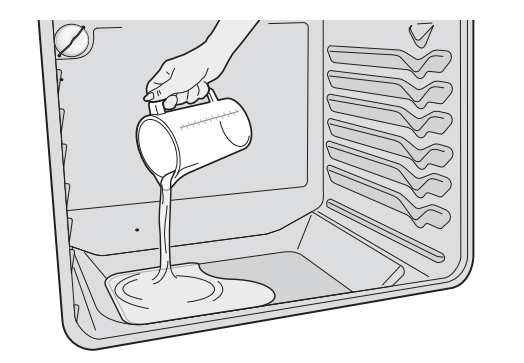
Figure 37: Pour water onto the oven bottom - Press Bake.
- Enter 170°F (77°C) using the arrow keys and press START.
- Set the minute timer for 10 minutes.
- Allow the oven to heat. Do not open the oven door while the oven is heating.
- An alert will sound when the timer is finished. Press Timer ON/Off to stop the timer and press
 to return to the clock.
to return to the clock. - Set the minute timer for 10 minutes to allow for a cool-down period. Do not attempt to wipe out the oven before a 10 minute cool-down period.
- An alert will sound when the timer is finished. Press Timer ON/Off to stop the timer.
- Stand to the side of the range out of the way of escaping vapor when opening the oven door.
- Wipe oven cavity and bottom. Do not clean oven door gasket (See Figure 38).
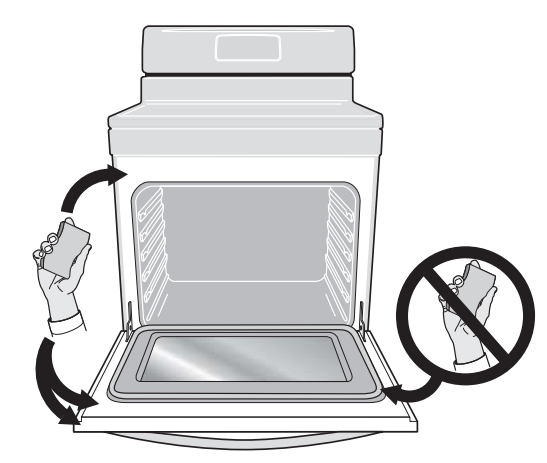
Figure 38: Do not clean the oven door gasket
To stop the steam cleaning cycle at any time, press 
Important notes:
- Always stay close to the oven when steam cleaning, so you can hear the timer alert.
- For best results, wipe out oven immediately after the cooldown period is complete.
- Removal of especially stubborn or baked-on soils may require a manual cleaning or a self clean cycle. See "Setting Self Clean" on page 32.
- Some condensation or water vapor may appear close to the oven vent, and some water may remain on the oven bottom. This is normal. Wipe with a soft cloth or sponge when the cool-down period is complete.
- The oven gasket may become damp; do not wipe dry. Open door to broil position and allow to air dry.
- Local water sources often contain minerals (hard water) and will leave deposits on the oven cavity surfaces. If this occurs, wipe cavity surfaces with diluted vinegar or lemon juice. Use distilled or filtered water.
- If the door is opened during steam cleaning or cool-down period, steam will escape and the oven may be more difficult to clean. Keep oven door closed during steam cleaning..
Care & Cleaning
Table 5: Cleaning recommendations
Surface Type | Recommendation |
Control knobs Painted body parts Painted decorative trim Aluminum, plastic or vinyl trim | For general cleaning, use hot, soapy water and a cloth. For more difficult soils and built-up grease, apply a liquid detergent directly onto the soil. Leave on soil for 30-60 minutes. Rinse with a damp cloth and dry. Do not use abrasive cleaners on any of these materials; they can scratch. To remove control knobs, turn to OFF position. Grasp firmly and pull straight off the shaft. To replace knobs after cleaning, line up the flat sides of both knob and shaft, then push knob into place. |
Control panel Control keypad membrane Decorative trim (some models) | Before cleaning the control panel, turn all controls off, activate oven lockout (on some models), and if needed remove any knobs from panel. Do not use abrasive cleaners on any of these materials; they can scratch. Clean using hot, soapy water and a cloth or sponge. Be sure to squeeze excess water from cloth or sponge before wiping control panel, especially when wiping around the controls area. Excess water in or around the controls may cause damage to the appliance. When rinsing, use clean water and a cloth or sponge and be sure to squeeze excess water from cloth or sponge before wiping the control panel. |
Porcelain enamel parts and door liner | Gentle scrubbing with a soapy non-abrasive scouring pad will remove most spots. Rinse with a 1:1 solution of clear water and ammonia. If necessary, cover difficult spots with an ammonia-soaked paper towel for 30 to 40 minutes. Rinse with clean water and a damp cloth, and then scrub with a soap-filled non-abrasive scouring pad. Rinse and wipe dry with a clean cloth. Do not allow food spills with high sugar or acid content (milk, tomatoes, sauerkraut, fruit juices, or pie filling) to remain on the surface; they may cause a dull spot even after cleaning. |
Oven interior | For oven interior remove excessive spillovers from oven cavity bottom before starting Self Clean. Clean any soils from oven frame and door liner outside the oven door gasket. For important cleaning precautions, read all the instructions in“Self Clean” on page 31. |
Oven racks | Remove oven racks from oven cavity before starting Self Clean. Clean by using a mild, abrasive cleaner following manufacturer's instructions. Rinse with clean water, dry, and then replace in oven. |
Oven door | Use soap and water to thoroughly clean the top, sides, and front of the oven door. Rinse well. You may use a glass cleaner on the outside glass of the oven door. Do not immerse the door in water. Do not spray or allow water or the glass cleaner to enter the door vents. Do not use oven cleaners, cleaning powders, or any harsh abrasive cleaning materials on the outside of the oven door. |
Ceramic cooktop | Do not use spray cleaners on the cooktop. See “Cooktop Maintenance” on page 35. |
Stainless Steel (some models) | Only use cleaners and polishes that are specifically manufactured for cleaning stainless steel. Always rub in direction of metal grain to avoid damaging. Do not use cleaners with high concentrations of chlorides or chlorine. Do not use harsh scrubbing cleaners. Polish with a lint-free cloth. Always be sure to wipe excess cleaner/polish off from the metal surface as bluish stains may occur during future oven heating that cannot be removed. Clean heavier soils with hot, soapy water and a cloth or sponge. Rinse and dry using clean water and a cloth. |
Cooktop Maintenance
Consistent and proper cleaning is essential to maintaining your ceramic glass cooktop.
Prior to using your cooktop for the first time, apply the recommended CookTop® Cleaning Creme to the ceramic surface (on the web visit www.sears.com for replacement cooktop cleaner, item number 40079). Buff with a non-abrasive cloth or sponge. This will make cleaning easier when soiled from cooking. The special cooktop cleaning cream leaves a protective finish on the glass to help prevent scratches and abrasions.
Sliding aluminum or copper clad bottom pans on the cooktop can cause metal markings on the cooktop surface. These marks should be removed immediately after the cooktop has cooled using the cooktop cleaning cream. Metal marks can become permanent if not removed prior to future use.
Cookware (cast iron, metal, ceramic or glass) with rough bottoms can mark or scratch the cooktop surface.
Do not:
- Slide anything metal or glass across the cooktop.
- Use cookware with dirt or dirt build up on bottom; replace with clean cookware before using.
- Use your cooktop as a cutting board or work surface in the kitchen.
- Cook foods directly on the cooktop surface without a pan.
- Drop heavy or hard objects on the ceramic glass cooktop, they may cause it to crack.
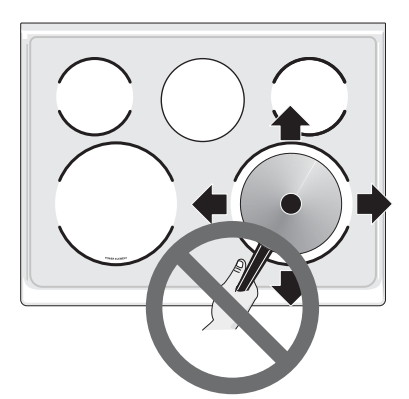
Figure 39: Cooktop care
Cooktop Cleaning
For light to moderate soil:
Apply a few drops of CookTop® Cleaning Creme directly to the cooktop. Use a paper towel or use a non-abrasive cloth or sponge to clean the entire cooktop surface. Make sure the cooktop is cleaned thoroughly, leaving no residue.
For heavy, burned on soil:
Apply a few drops of CookTop® Cleaning Creme directly to the soiled area. Rub the soiled area using a non-abrasive cleaning tool, applying pressure as needed. Do not use the pad you use to clean the cooktop for any other purpose.
If soils remain, carefully scrape soils with a metal razor blade scraper, holding scraper at a 30 degree angle to the surface. Remove loosened soils with cooktop cleaning cream and buff surface clean.
Plastic or foods with a high sugar content need be removed immediately if spilled or melted onto the ceramic cooktop surface. Permanent damage (such as pitting of the cooktop surface) may occur if not removed immediately. After turning the surface elements off, use a razor blade scraper or a metal spatula with a mitt and scrape the soil from the hot surface (as illustrated). Allow the cooktop to cool, and use the same method for heavy or burned on soils.

Figure 40: Cooktop cleaning
Plastic or foods with a high sugar content need be removed immediately if spilled or melted onto the ceramic cooktop surface. Permanent damage (such as pitting of the cooktop surface) may occur if not removed immediately. After turning the surface elements off, use a razor blade scraper or a metal spatula with a mitt and scrape the soil from the hot surface (as illustrated). Allow the cooktop to cool, and use the same method for heavy or burned on soils.
Do not use the following on the cooktop:
- Do not use abrasive cleaners and scouring pads, such as metal and some nylon pads. They may scratch the cooktop, making it more difficult to clean.
- Do not use harsh cleaners, such as chlorine bleach, ammonia or oven cleaners, as they may etch or discolor the cooktop.
- Do not use dirty sponges, cloths or paper towels, as they can leave soil or lint on the cooktop which can burn and cause discoloration.
Important note: Damage to the ceramic glass cooktop may occur if you use an abrasive type cleaning pad. Only use cleaning products that have been specifically designed for ceramic glass cooktops.
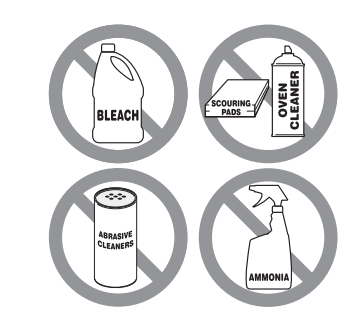
Figure 41: Cleaning products to avoid
General Cleaning
Refer to Table 5 for more detailed information about cleaning specific parts of the range.
- Aluminum foil - Use of aluminum foil on a hot cooktop can damage the cooktop. Do not use thin aluminum cooking utensils or allow aluminum foil to touch the surface elements under any circumstances.
- Aluminum utensils - The melting point of aluminum is much lower than that of other metals. Care must be taken when aluminum pots or pans are used on the cooktop. If aluminum pans are allowed to boil dry when using the cooktop, not only will the utensil be damaged or destroyed, but it may fuse to, break, or mark the ceramic glass surface, permanently damaging the cooktop surface.
Replacing oven light (some models)
To replace the interior oven light bulb:
The oven light is located at the rear of the oven cavity and is covered with a glass shield held by a wire holder. The glass shield protects the light bulb and must be in place whenever the oven is in use.

Figure 42: Replacing the oven light
Be sure the range is unplugged and all parts are cool before replacing oven light. Wear a leather-faced glove for protection against possible broken glass.
- Turn electrical power off at the main source or unplug the range.
- Press wire holder to one side to release the glass shield that covers the light bulb.
- Replace light with a new 40 watt appliance bulb.
- Replace glass shield over bulb and snap wire holder back into place.
- Turn power on at the main source (or plug the appliance in).
- The clock will then need to be reset. To reset, see “Setting Clock” on page 18.
Removing and replacing the lift-off oven door
To remove the oven door:
- Open oven door completely (horizontal with floor -Figure 43).
- Pull the door hinge locks on both left and right door hinges down from the oven frame completely towards the oven door (Figure 44). A tool such as a small flat-blade screwdriver may be required.
- Firmly grasp both sides of oven door along the door sides (Do not use the oven door handle - Figure 45).
- Close the door to the broil stop position (the oven door will stop into this position just before fully closing).
- With the oven door in the broil stop position, lift the oven door hinge arms over the roller pins located on each side of the oven frame (Figure 46).

Figure 43: Oven hinge locations
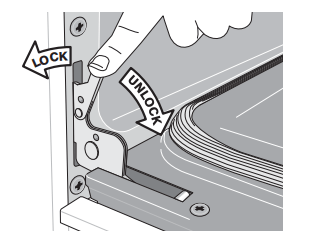
Figure 44: Hinge lock/unlock positions

Figure 45: How to remove door
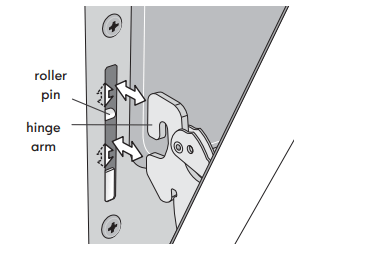
Figure 46: Hinge pin locations
To replace oven door:
- Firmly grasp both sides of oven door along the door sides (Do not use the oven door handle - Figure 45).
- Holding the oven door at the same angle as the removal position, seat the hook of the hinge arm over the roller pins located on each side of the oven door frame (Figure 46). The hook of the hinge arms must be fully seated onto the roller pins.
- Fully open the oven door (horizontal with floor - Figure 43).
- Push the door hinge locks up towards and into the oven frame on both left and right oven door hinges (Figure 44) to the locked position; then, close the oven door.
Special care instructions
Most oven doors contain glass that can break. Follow these recommendations:
- Do not close the oven door until all the oven racks are fully in place inside the oven cavity.
- Do not hit the glass with pots, pans, or any other object.
- Scratching, hitting, jarring, or stressing the glass may weaken its structure causing an increased risk of breakage at a later time.
Before You Call
Oven Baking
For best cooking results, heat the oven before baking cookies, breads, cakes, pies, pastries, et cetera. There is no need to preheat the oven for roasting meat or baking casseroles. The cooking times and temperatures needed to bake a product may vary slightly from your previously owned appliance.
Baking Problems and Solutions | ||
Baking Problems | Causes | Corrections |
Cookies and biscuits burn on the bottom.  | Cookies and biscuits put into oven before the preheating time is completed. Oven rack is overcrowded. Dark pans absorbs heat too fast. | Allow oven to preheat to desired temperature before placing food in oven. Choose pan sizes that will permit 2” to 4” of air space (5.1 cm o 10.2 cm) on all sides when placed in the oven. Use a medium weight baking sheet. |
Cakes too dark on top or bottom  | Cakes put in oven before preheating time is completed. Rack position too high or too low. Oven too hot. | Allow oven to preheat to the selected temperature before placing food in the oven. Use proper rack position for baking needs. Set oven temperature 25°F (13°C) lower than recommended. |
Cakes not done in center  | Oven too hot. Incorrect pan size. Pan not centered in oven. Glass cookware slow heat conductor. | Set oven temperature 25°F (13°C) lower than recommended. Use pan size suggested in recipe. Use proper rack position and place pan so there is 5.1 cm to 10.2 cm (2” to 4”) of space on all sides of pan. Reduce temperature and increase cook time or use shiny bakeware. |
Cakes not level.  | Oven not level. Pan too close to oven wall or rack overcrowded. Pan warped. | Place a marked glass measuring cup filled with water on the center of the oven rack. If the water level is uneven, refer to the installation instructions for leveling the oven. Be sure to allow 5.1 cm to 10.2 cm (2” to 4”) of clearance on all sides of each pan in the oven. Do not use pans that are dented or warped. |
Foods not done when cooking time is over.  | Oven too cool. Oven overcrowded. Oven door opened too frequently. | Set oven temperature 25 F (13 C) higher than suggested and bake for the recommended time. Be sure to remove all pans from the oven except the ones to be used for baking. Open oven door only after shortest recommended baking time. Make sure to allow 2” to 4” of clearance between all pans and racks, allowing for even air flow. |
Solutions to Common Problems
Before you call for service, review the following list. It may save you time and expense. Possible solutions are provided with the problem listed:
Problem | Solution |
| Poor baking results |
|
| Appliance is not level. |
|
| Cannot move appliance easily. Appliance must be accessible for service |
|
| Entire appliance does not operate. |
|
| Oven portion of appliance does not operate. |
|
| Surface element is too hot or not hot enough |
|
| Surface element does not heat or does not heat evenly |
|
| Oven light does not work |
|
| Oven smokes excessively when broiling. |
|
| Flames inside oven or smoking from oven vent. |
|
| Oven control panel beeps and displays any F code error. |
|
| Self Clean does not work. . |
|
| Soil not completely removed after Self Clean. |
|
| Oven racks discolored. |
|
| Convection fan does not rotate |
|
| Scratches or abrasions on cooktop surface. |
|
| Metal marks on the cooktop. |
|
| Brown streaks or specks on cooktop surface. |
|
| Areas of discoloration with metallic sheen on cooktop surface. |
|
See other models: 29453 74102 42529 89308 92559